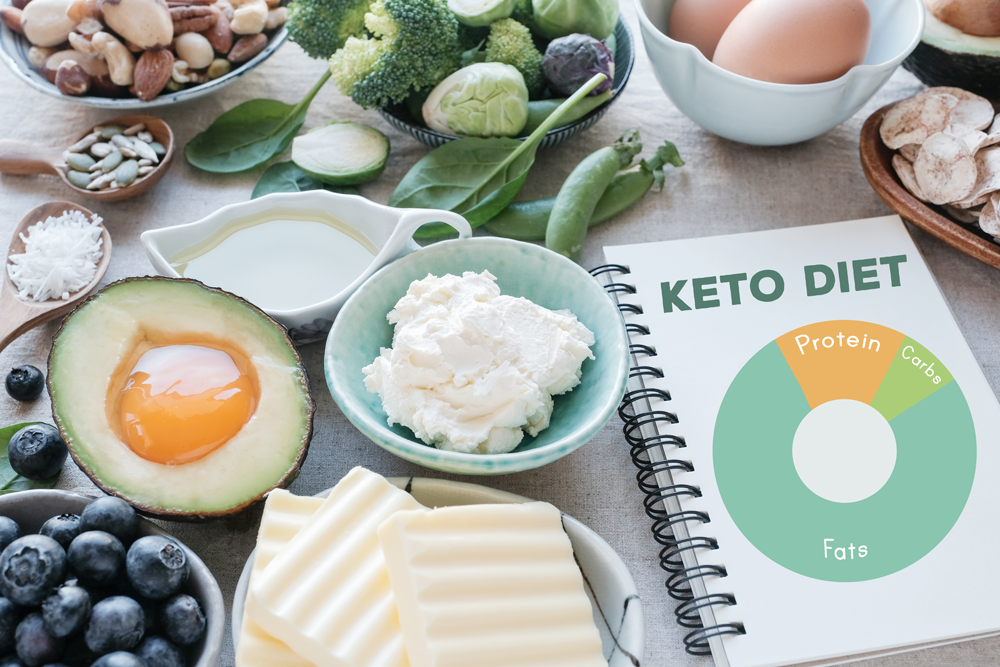What is a keto diet?
The ketogenic diet is the ultimate low carb diet. It’s moderate in terms of protein and very high in fat.
In essence, it’s similar to the Atkins diet that was first created in the 1970s, but its fans like to describe it as a more modern version of it, now with a solid scientific basis. Like the Atkins diet, the ketogenic diet aims to keep the body in permanent ketosis. Your body will switch its fuel supply to run mostly on fat, and it will burn fat 24-7. The keto diet is, therefore, great if you’re trying to lose weight, but there are many other benefits like feeling less hungry, feeling mentally focussed, and banishing the energy slumps that come with eating a high carb diet.
How does the keto diet work?
Glucose is the easiest molecule for your body to convert and use as energy so that it will be chosen over any other energy source. Insulin is produced to process the glucose in your bloodstream by taking it into the cells. It’s the fat-storage hormone secreted in direct proportion to the type and quality of carbs consumed. When you lower the intake of carbs in your diet, you force the body into the fat-burning state of ketosis.
Ketosis is a natural process that helps you survive when food intake is low. When in this state, you produce ketone bodies or ketones, and these are made from the breakdown of fats in the liver. They are an alternative source of energy. Energy from ketones works just as well and feels no different – better if anything – and the brain actually prefers ketones.
Who should not try the keto diet?
For most people, the ketogenic diet appears to be very safe, but you should not try it before you have consulted with a doctor if you:
-
- Take medication for diabetes, like insulin.
- Have kidney disease.
- Take blood pressure medication.
- Are pregnant or breastfeeding.
- Are suffering or recovering from an eating disorder.
What do you eat?
The ketogenic diet is largely based on protein and fat and is filling and satisfying. This means no hunger cravings and consistent energy levels. The downside is the diet is very strict. A typical keto diet allows only up to 50g of net carbs a day. Just so you know, many people following a typical Western diet can consume 250g or more of carbs in a day. It’s fair to say that, for many,
it’s learning a whole new way of eating – but the benefits can be worth it.
Cutting out carbs means more than just avoiding the bread, pasta, rice and potatoes that we think of as carbohydrates, but also other foods including many fruits and a number of starchy vegetables and even some nuts, such as cashews. What you might not be prepared for is having to cut back on alcohol (it’s not cut it out entirely – spirits are OK but watch the sugary mixers -,
and champagne and wine are not so bad in moderation but it very much depends on your sensitivity to carbs), and your favourite cappuccino or latte, too. Instead of focussing on all the foods you’ll be cutting out, I want you to look at all the delicious, satiating and nourishing foods you’ll be able to enjoy.
IN:
Meat, fish, poultry, eggs. Leafy Greens like spinach and kale. Above-ground vegetables like broccoli, cauliflower, etc. High-Fat Dairy like hard cheeses, cream, butter, etc. Nuts and Seeds. Avocado. Berries- raspberries, strawberries, blueberries, blackberries, and other low GL berries. Other fats- coconut oil, high-fat salad dressings, saturated fats, etc.
OUT:
Grains like wheat, corn, rice, barley
Sugars: honey, agave, maple syrup
Fruit like apples, bananas, oranges
Potato, yams, etc
The keto Challenge
If you’ve tried the keto diet before, you’ll know the real challenge is sticking to it for the first seven days. That’s how long it might take for your body to adapt. You’ll have passed some of the initial side effects – some people experience ‘keto flu’ and you’ll have figured out exactly what to eat to replace all the carbs.
Keto Flu and other side effects
During the transition to ketosis, some people experience what’s known as ‘keto flu’ – flu-like symptoms like headaches, brain fog, tiredness, nausea, muscle cramps, lack of motivation, and weakness. This happens when the body runs out of glucose and has not yet learned to switch to using fat for energy – that’s because it hasn’t had to for such a long time. Until you become ‘fat adapted’ (i.e., your body has re-learned to use fat) there is a period of low energy. It is this taxing time that can put people off.

How to know you’re in ketosis
Symptoms of your body getting into ketosis might be increased mental alertness or having more energy. You might also experience reduced hunger. Many people report having ‘keto breath’, which is a bit like pear drops rather than anything too unpleasant. This results from the acetone, one of the ketone bodies. Expect it to pass in a week or two. To start, you might also notice you need to urinate more often.
The only sure-fire way to know you’re in ketosis is to measure it.
Initially, you can do this through strips to test your urine, which are relatively inexpensive, and you can get these from most pharmacies and online. As you become more fat-adapted, your body will start using those ketones for energy, so there are fewer left in the urine to measure.


Blood ketone meters measure your blood ketone levels and are considered the gold standard – the most accurate way to measure your ketones. You prick your finger using a lancet and drop a little blood onto a test strip, which is analysed by the monitor. These are now relatively inexpensive and can be bought from pharmacies and online.
You can also use a breath analyser, which is by far the most convenient way, if a little expensive in terms of the initial purchase. Simply breathe into the mouthpiece to reveal your score. Some work in conjunction with an app on your phone. A good investment if you decide that, longer-term, the keto diet is what you need.
To get into ketosis safely and effectively, you’ll want to:
- Stick to 50g or fewer net carbs.
- Combine with intermittent fasting. Going for 16-18 hours without eating can help you get into ketosis faster and is easily achieved. Start by just skipping your usual breakfast.
- Use coconut oil for cooking or MCT oil in your keto coffee. These contain medium-chain fatty acids that boost ketone production.
- Move your body gently. While you are transitioning into ketosis, don’t take on hardcore exercise – you can end up flagging pretty quickly, feeling like you ‘hit the wall’. Instead, take a brisk walk in a fasted state. This will help your body dip into fat for fuel.
- Ensure you eat enough fat. You may be accustomed to avoiding fat (especially if you’ve been on weight loss diets before). Fat supplies the energy you are no longer getting from carbs – and this is the difference between starving yourself and being on a ketogenic diet.
- Don’t snack. Allow your body to rest. Eating more often than you need to also slows down weight loss and reduces ketosis.
Keto Coffee
Keto coffee makes a great breakfast and this recipe – devised by nutritionist Patrick Holford – is the best I’ve found.
The fat levels help keep you full until lunch, while the caffeine keeps you perky
(although it’s OK to use decaf if you prefer). Of all the nuts, almonds are the best choice because they are very low in carbs. A flat tablespoon, or a heaped dessertspoon, will give you only about 2g of carbs, plenty of healthy fats and some protein. This amount of carbs is not enough to take you out of ketosis.
C8 oil is a natural fat that the body can use to directly make ketones, switching on ketosis. This kind of oil is also called MCT oil.
Important
You need to buy carb-free almond milk. It must say ‘zero carbs’. Check the nutritional values on the back of the carton for the carbohydrate content, which must say 0. Example, Alpro Unsweetened.
It is important to note that when it comes to an optimal diet, there is no one size fits all and that the keto diet may not be right for you.
Ingredients
- 120ml no-carb almond milk (unsweetened)
- 120ml filtered coffee
- 1 flat tbsp (16g) almond butter
- 1–3 tsp C8 oil
- ½ rounded tsp cacao powder
- ⅓ tsp cinnamon
Method
Add all the ingredients together and whizz in a small blender or with a mini battery-operated whisk to emulsify the ingredients.
You can gently heat the coffee mixture in a pan if you prefer it hot rather than cool.

